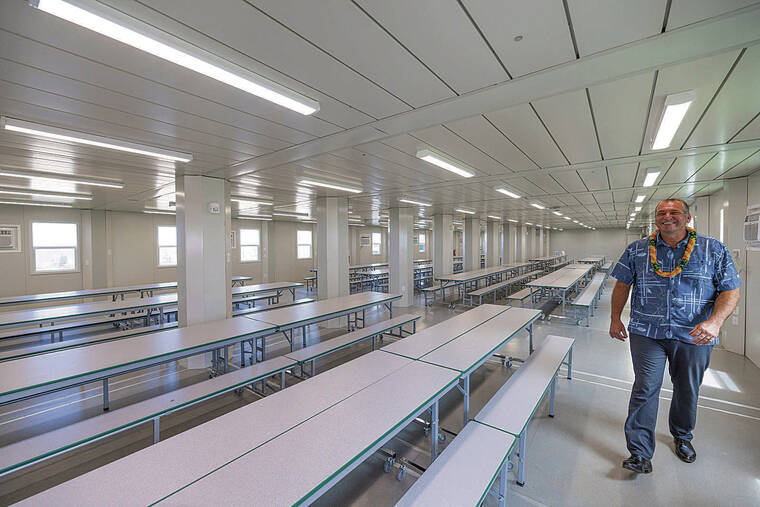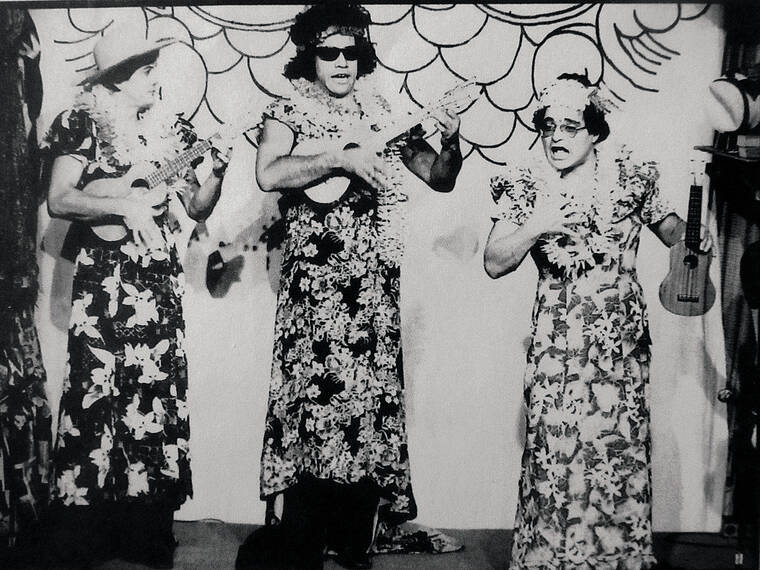Temporary school called ‘small miracle’ after Lahaina fire

BRYAN BERKOWITZ / SPECIAL TO THE STAR-ADVERTISER
Teachers, above, held hands Monday and sang a Lahaina mele, or song, at the blessing ceremony of the temporary King Kamehameha III Elementary School in Pulelehua, Maui, below.

BRYAN BERKOWITZ / SPECIAL TO THE STAR-ADVERTISER
Temporary King Kamehameha III Elementary School in Pulelehua, Maui, above.

BRYAN BERKOWITZ / SPECIAL TO THE STAR-ADVERTISER
Above, King Kamehameha III Elementary School Principal Ian Haskins on Monday led a tour of the cafeteria at the new temporary facility in Pulelehu, Maui.



Glancing at the new temporary school on a grassy slope in Pulelehua, Maui, casual onlookers might perceive a simple cluster of boxy modular buildings hurriedly erected in just over three months, but Gov. Josh Green calls the school’s rapid construction “a small miracle” in the wake of a disaster, and he and others also see the beginnings of healing and hope.
“It is a small miracle that in just 95 days a school has been created. We need some small miracles here after the fire that we suffered,” Green said Monday to about 100 educators and dignitaries gathered to launch the temporary campus replacing King Kamehameha III Elementary School, lost in the Aug. 8 Lahaina wildfires.
“This is the place where most kids are going to find their normal moments, their stable moments,” Green said.
Stability is indeed what students, teachers and families of King Kamehameha III Elementary have been longing for after changing schooling arrangements four times since their campus on Front Street was damaged beyond repair, among the approximately 4,000 Maui structures claimed by flames in August.
Soon after the fires, King Kamehameha III Elementary students were initially offered temporary enrollment at other campuses and programs, later transitioned to “learning hubs” in community locations, then in October began classes in tent structures, sharing the Princess Nahi‘ena‘ena Elementary School campus above Lahaina town.
Many educators have expressed concern about trauma, attendance problems and learning loss for many students across the Valley Isle in the wake of the disaster.
Don't miss out on what's happening!
Stay in touch with breaking news, as it happens, conveniently in your email inbox. It's FREE!
On Monday in Pulelehua, about 7 miles north of their original campus, King Kamehameha III Elementary teachers and staff began moving first into the 30 air-conditioned, fully furnished modular classrooms and other buildings.
While the structures look industrial on the outside, teachers on this day were busy making the classroom spaces inside as homey and comfortable as possible, laying out school supplies and labeling desks with students’ names, in anticipation of their young charges coming back Monday from an extended spring break to their new campus.
“This year has been full of challenges on many levels with lots of layers of emotions,” Ian Haskins, principal of King Kamehameha III Elementary, said at the dedication. “Through the three previous transitions, we have persevered by working together. This has been an unprecedented year, and together we can create the best environment for our students, teachers and the whole community.”
School cost $78 million
The modular structures sit amid freshly laid panels of bright green grass sod panels and concrete walkways, with a panoramic view of the ocean below, the West Maui mountains soaring behind.
The temporary campus also sports an administration building, library, student support center, cafeteria and play areas. Some classrooms will be used as resource rooms for art, a computer lab and special education. Some space also will be set aside for Kaiapuni Hawaiian language immersion students and teachers, who for months have been pleading with state education officials for space for in-person learning.
The Federal Emergency Management Agency helped to fund the approximately $78 million temporary school. Contractors were charged with placing 337 modular units to form 10 large and 20 small classrooms, according to an U.S. Army Corps of Engineers description of the project.
The corps handled the construction of the project and subcontracted Pono Aina Management, an 8(a) Native Hawaiian organization. The federal 8(a) program was created to help firms owned and controlled by socially and economically disadvantaged people.
The temporary school site will operate for up to five years, while plans for a permanent replacement school “will involve engaging the community and be coordinated with broader planning for the rebuilding of Lahaina,” a state Department of Education news release said.
While the original King Kamehameha III Elementary enrolled more than 600 students before the fires, and the new temporary replacement campus has been built with a capacity for that many, only about 350 students are expected there, at least at the outset.
“We acknowledge that everyone has to make their own minds up about where they would like to be educated, where their place of trauma is, how they will come to recover,” Green said. “We don’t expect all 600 students to come back to this campus, but we want options for our students. And that’s why we’re so grateful to be able to do this now.”
School built quickly
Col. Eric Swenson, recovery field office commander with the U.S. Army Corps of Engineers, said in his remarks that putting up the school in 95 days was a “Guinness world record-like feat,” and added that it actually was done in 85 workdays since inclement weather took out 10 days.
“We got this work done because the hands behind the tools were vested in the community and committed to delivering for their families, their neighbors, their neighborhoods and their community,” Swenson said.
State schools Superintendent Keith Hayashi said the project’s rapid rise is due to many departments working united in purpose. “I look forward to Principal Haskins and our students and staff being able to fill this space with aloha and a love for learning for many years to come,” he said. Other dignitaries who attended the dedication included U.S. Sen. Mazie Hirono, U.S. Rep. Jill Tokuda, state Board of Education Chair Warren Haruki and state Rep. Justin Woodson (D, Kahului-Puunene), chair of the state House Committee on Education.
A Hawaiian ceremony incorporated the blowing of a conch shell and chants by cultural practitioner Kaniala Masoe of Maui. After the blessing, about two dozen King Kamehameha III Elementary teachers held hands in a circle and sang a Lahaina mele, or song.
Some items from the original campus have been salvaged and relocated to the site, including a 6,000-pound bronze bust of King Kamehameha III, and a green-and-white cattle gate.
“As this community looks to heal, it will require many hands and minds at work,” Swenson said. He added that as a father of three himself, he understands that “for those parents who have been juggling kids and work, all while grieving, I know getting your kids back to a normal routine means giving you time to get to the test of rebuilding.”




